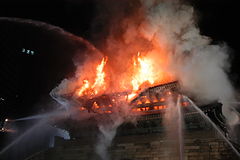
Arson is the act of willfully and deliberately setting fire to or charring property. Although the act of arson typically involves buildings, the term can also refer to the intentional burning of other things, such as motor vehicles, watercraft, or forests. The crime is typically classified as a felony, with instances involving risk to human life or property carrying a stricter penalty. Arson that results in death can be further prosecuted as manslaughter or murder. A common motive for arson is to commit insurance fraud. In such cases, a person destroys their own property by burning it and then lies about the cause in order to collect against their insurance policy. Arson is also often committed to conceal another crime, such as murder or burglary.

Namdaemun, officially known as the Sungnyemun, is one of the Eight Gates in the Fortress Wall of Seoul, South Korea. The gate formed the original southern boundary of the city during the Joseon period, although the city has since significantly outgrown this boundary. It is located in Jung District between Seoul Station and Seoul Plaza, with the historic 24-hour Namdaemun Market next to the gate.
Radford Semele is a village and civil parish in Warwickshire, England, situated close to the Regency spa town of Leamington Spa. According to the 2001 Census, Radford Semele parish has a population of 2,448, according to 2021 census. It lies on the A425 between Leamington and Southam. It has a 16th-century pub with a priest hole. The local school is the Radford Semele Church of England School. This is a primary school and most senior pupils go to school in either Southam, Leamington Spa or Warwick which are close by. As well as the parish church of St Nicholas the village also has a second church built in 1874, the Radford Semele Baptist Church.

The Old Fire was a large complex wildfire that started on October 25, 2003, near Old Waterman Canyon Road and California State Route 18 in the San Bernardino Mountains, in San Bernardino County, Southern California, United States. The Old Fire caused at least $1.2 billion in damages.
John Leonard Orr is an American convicted serial arsonist, mass murderer and former firefighter. A fire captain and arson investigator in Glendale, California, Orr was convicted of serial arson and four counts of murder; he is believed to have set nearly 2,000 fires in a 30 year arson spree, most of them between 1984 and 1991, making him the most prolific serial arsonist in American history.

The Texas Governor's Mansion is a historic home for the governor of Texas in downtown Austin, Texas. Designed by prominent architect Abner Cook, it was built in 1854 and has been the home of every governor since 1856. Governor Greg Abbott and First Lady Cecilia Phalen Abbott are the current residents.

The Esperanza Fire was a large, wind-driven, arson-caused wildfire that started on October 26, 2006, in a river wash near Cabazon, California, United States, west of Palm Springs. By October 29, 2006, it had burned over 41,173 acres (166.62 km2) and was 85% contained. On October 30, 2006, the fire was fully contained.
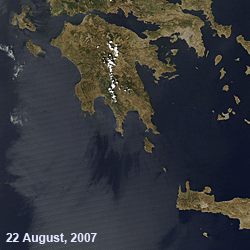
The 2007 Greek forest fires were a series of massive forest fires that broke out in several areas across Greece throughout the summer of 2007. The most destructive and lethal infernos broke out on 23 August, expanded rapidly and raged out of control until 27 August, until they were finally put out in early September. The fires mainly affected western and southern Peloponnese as well as southern Euboea. The death toll in August alone stood at 67 people. In total 85 people lost their lives because of the fires, including several fire fighters.
The Nonhyeon-dong massacre was a mass murder that occurred in Gangnam District, Seoul, South Korea on October 20, 2008, when 30-year-old Jeong Sang-jin (정상진) set fire to a goshiwon and slashed several women with a sashimi knife. A total of six people died in the incident, and seven more were injured. Jeong was sentenced to death on May 12, 2009.

The Black Saturday bushfires were a series of bushfires that either ignited or were already burning across the Australian state of Victoria on and around Saturday, 7 February 2009, and were one of Australia's all-time worst bushfire disasters. The fires occurred during extreme bushfire weather conditions and resulted in Australia's highest-ever loss of human life from a bushfire, with 173 fatalities. Many people were left homeless and family-less as a result.
The Coatesville, Pennsylvania arsons refer to a spree of deliberately set fires in 2008 and 2009 in the area of Coatesville, Pennsylvania, a small Philadelphia suburb. There were 26 fires set in Coatesville in the year 2008 and, since January 1, 2009, there have been 18 reported cases of arson in the city and five more in the surrounding area. The fires have caused more than $3 million in damage, left scores of people homeless and resulted in the death of one 83-year-old woman. As of March 2009, six people have been arrested in connection with some of the fires.

The Mount Carmel Forest Fire was a deadly forest fire that started on Mount Carmel in northern Israel, just south of Haifa. The fire began at about 11:00 local time on 2 December 2010, and spread quickly, consuming much of the Mediterranean forest covering the region. With a death toll of 44, it was the deadliest civil disaster in Israeli history until the 2021 Meron stampede. Those killed included 36 Israel Prison Service members, most of them new recruits, as well as three senior police officers, among them the chief of Haifa's police, and three firefighters, among them a 16-year-old volunteer. More than 17,000 people were evacuated, including several villages in the vicinity of the fire, and there was considerable property and environmental damage.
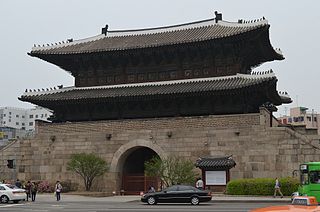
The Eight Gates of Seoul are a series of historic gates located in Seoul, South Korea. Two of the gates are now destroyed, although the others are still standing. The gates were constructed between 1396 and 1398, and allowed access to the city, which was surrounded by the Fortress Wall during the Joseon period.

Dunston is particularly known for wooden coal staiths, first opened in 1893 as a structure for loading coal from the North Durham coalfield onto ships. In the 1920s, 140,000 tons of coal per week were loaded from the staiths, and they continued to be used until the 1970s. They were also a shipping point for coke produced at the nearby Norwood Coke Works, as well as pencil pitch manufactured at the Thomas Ness Tar Works using by-products from the Norwood plant and the Redheugh Gasworks. Throughout their working life, motive power for shunting wagons on the staiths and in their extensive sidings known as the Norwood Coal Yard came in the form of locomotives from Gateshead MPD. The staiths' output gradually declined with the contraction of the coal industry, and they were finally closed and partially dismantled in 1980. Now redundant, the railway lines leading to the staiths were lifted, finally allowing the demolition of several low bridges that had become a nuisance to bus operators by limiting the routes available to double-deckers in the area. For many years, the men who worked on the staiths, known as teemers and trimmers, had their own room in the nearby Dunston Excelsior Club. For anyone not employed in the club or on the staiths, access to the room was strictly by invite only, and the staithesmen held a reputation for unceremoniously ejecting anyone who fell foul of this rule.
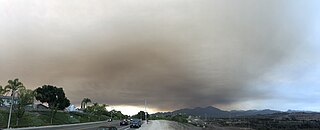
The Holy Fire was a wildfire that burned in the Cleveland National Forest in Orange and Riverside Counties, California. The wildfire started on August 6, 2018, at around 1:15 PM PDT, in the vicinity of Trabuco Canyon. A suspected arsonist was booked into the Orange County jail in Santa Ana, California but found not guilty in 2023. The blaze burned 23,136 acres (94 km2) and destroyed 18 buildings, before it was fully contained on September 13, 2018. While the fire was actively spreading in early and mid-August, residents of the nearby cities of Corona, Temescal Valley, and Lake Elsinore were placed under evacuation orders.
The Palisades Fire was a wildfire that burned in Topanga State Park, in the Pacific Palisades neighborhood of the city of Los Angeles, California on May 14, 2021. The fire burned a total of 1,202 acres (486 ha) and was fully contained on May 26, 2021.
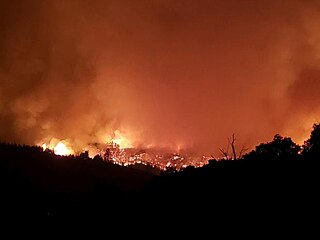
The Dolan Fire was a large wildfire that burned in the Big Sur region and other parts of the Santa Lucia mountain range in Monterey County, California, in the United States as part of the 2020 California wildfire season. The fire began at approximately 8:15 p.m. on August 18, 2020. On September 8, 15 firefighters were injured, one critically, when they were forced to deploy emergency fire shelters at Nacimiento Station. Ten adult California condors and two chicks died in the blaze, which began about a mile south of the Big Sur Condor Sanctuary in Monterey County. The nonprofit Ventana Wildlife Society of Monterey lost a sanctuary that has been used to release the captive-bred condors into the wild since 1997. While no people or condors were at the 80-acre (32 ha) site, a research building, pens, and other facilities were destroyed.
On 9 June 2022, a fire caused by a suspected arson attack broke out at an office building in Daegu, South Korea, killing seven people and injuring 49 others. Among the dead was the suspected arsonist, who was reported to have started the fire in a lawyer's office.
